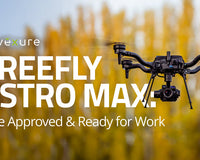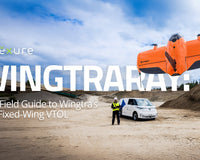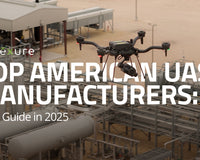Rick manages nearly 3,000 acres of corn and soy across the Midwest. Each season brings familiar challenges: rising input costs, unpredictable rainfall patterns, and yield discrepancies that don’t make any sense. He tracks soil data, monitors yield maps, and scouts, yet too often the real causes behind crop stress remain hidden until it’s too late.

Some areas emerge unevenly. Others show subtle discoloration that he can’t quite figure out. When pests or nutrient deficiencies appear, he reacts, but the window to prevent losses has already closed. His data tools help him measure outcomes, but not anticipate them.
These frustrations aren't unique to Rick. Across North America, even well-equipped farms still struggle to capture and interpret field-level intelligence at the right scale. Studies from the U.S. The Department of Agriculture shows that while precision technologies like yield monitors and soil mapping are widely used, more advanced aerial and sensor-based imaging tools remain far less common.
Many farms simply don’t have the tools or staff in place to turn raw data into clear decisions they can act on.
That’s where drones can help. Unlike satellites or airplanes that offer coarse imagery on fixed schedules, drones give growers on-demand, high-resolution views of their crops. They can detect subtle changes in canopy health long before stress becomes visible on the ground. That means you can pinpoint exactly where emergence is lagging, where water isn’t penetrating, or where nitrogen isn’t doing its job, before those issues show up in your yield maps.
In this guide, we’ll explore how to start incorporating drone data into everyday farm management. You’ll learn which types of data matter most and how to capture and process them into meaningful decisions.
Why Drone Data Matters in Modern Agriculture
Before deciding on which drone or software to buy, start by asking the right questions. The most successful operations don’t begin with equipment; they begin with the end goal in mind.
What are your goals for using drones?
Every grower’s priorities are different, but most fall into one or more of these categories:
-
Detect crop stress early: Identify issues with pests, disease, or nutrient deficiency before they spread.
-
Measure stand counts: Quantify germination success and evaluate planter performance.
-
Optimize input use: Generate prescription maps for variable-rate fertilization, irrigation, or spraying.
-
Validate management decisions: Compare treatment areas or hybrids throughout the growing season.
-
Assess field variability over time: Build long-term data sets to understand trends across seasons.
What types of crops are you growing?
Your crop type shapes both the sensors and data you’ll need:
-
Row crops (corn, soy, wheat, potatoes) benefit most from multispectral sensors that detect subtle differences in vigor and chlorophyll content.
-
Orchards and vineyards require higher-resolution RGB or thermal imagery to monitor tree health, canopy density, and water stress.
-
Specialty or mixed operations may use both: RGB for visible damage, multispectral for vegetative analysis.
What insights are you hoping to uncover?
Some growers want a big-picture health map, while others want data tied to specific tasks. Drones can provide both.
-
For NDVI and NDRE vegetation indices, you can track plant vigor and nitrogen uptake.
-
For stand counts, image analytics help confirm population density and early-season emergence.
-
For thermal analysis, imagery reveals irrigation performance water-stress zones, and crop transpiration information
Once you define these, everything else (platform choice, flight frequency, and processing software) start to fall into place. A corn producer that uses variable-rate fertilization may need a different workflow than a vineyard monitoring plant vigor, but their end goals are the same:
Use precise aerial intelligence to make data-driven adjustments that optimize yield, minimize waste, and prevent risk.
Choosing the Right Drone Platform for Your Farm
Selecting a drone is less about chasing specs and more about matching the tool to your workflow. What problem are you solving, and how much precision do you need?
Step 1: Define the Scale of your Operation
A 200-acre farm and a 3,000-acre operation have different coverage needs.
-
Small-to-mid operations often benefit from compact, quick-launch drones that can fly one or two fields per battery cycle.
-
Large farms might need longer flight times, swappable batteries, or modular sensors to handle wide acreage efficiently.
This isn’t about getting the biggest drone; it’s about efficiency. A well-chosen mid-sized drone can deliver better results than a high-end model that’s cumbersome and hard to deploy.
Step 2: Choose the Right Sensor
The camera or sensor is what turns a flight into data. For precision agriculture, this choice determines what you can measure.
-
Multispectral cameras detect near-infrared light and calculate vegetation indices, like NDVI and NDRE, are ideal for tracking plant vigor and nutrient stress.
-
RGB sensors provide true-color images used for mapping, counting, and visual inspection.
-
Thermal sensors reveal temperature differences that signal irrigation issues or canopy stress.
Most growers begin with multispectral & RGB imaging and add additional sensing (e.g. thermal, hyperspectral, etc.) only when the workflow calls for it.
Step 3: Prioritize Accuracy and Repeatability
Agricultural intelligence depends on spatial accuracy. Without precise positioning, data can’t be compared week-to-week or season-to-season.
-
Look for RTK (Real-Time Kinematic) positioning, which corrects GPS drift down to centimeter-level accuracy.
-
If RTK isn’t available in your area, PPK (Post-Processed Kinematic) can achieve similar results after the flight.
This accuracy is what makes prescription mapping and variable-rate applications possible.
Step 4: Match the Platform to the Data You Need
Once you know what insights matter, the platform choice narrows naturally:
-
For NDVI or NDRE analysis, drones like the DJI Mavic 3 Multispectral combine efficiency with integrated multispectral sensors.
-
For larger fields or research-grade imagery, a Matrice 400 paired with a MicaSense RedEdge-P offers more flexibility and higher data quality.
-
For general mapping and scouting, the DJI Matrice 4 Enterprise captures detailed RGB imagery that can still feed into mapping software for surface models or stand counts.
Step 5: Think about Usability and Support
Ease of deployment matters more than many first-time operators expect. The drone that’s easiest to unpack, calibrate, and fly consistently is the one that will actually be used.
Think About:
-
Battery life relative to field size
-
Data-transfer simplicity (SD card vs. cloud)
-
Compatibility with your preferred software ecosystem
-
Dealer or integrator support for setup, training, and maintenance
A capable system is one that fits seamlessly into your routine rather than adding friction to it.
Turning Flight Data into Usable Insights
Whether you fly the drone yourself or work with a crop scout, understanding what the imagery shows helps you ask better questions, act faster, and get more value from every flight.
Once your drone is in the air, every image, pixel, and GPS coordinate captured in flight becomes raw data that’s only valuable once it's processed, analyzed, and interpreted correctly.
It’s not just about collecting pictures; it’s about creating structured datasets that reveal patterns invisible from the ground.
From Images to Insights
Each flight produces hundreds (sometimes thousands) of overlapping images. These are stitched into a single orthomosaic (a geometrically corrected, map-accurate image of the field). This process, called photogrammetry, reconstructs spatial relationships by aligning images using ground control points or RTK/PPK metadata.
From that orthomosaic, analytics software extracts multiple data layers:
-
RGB (True Color): Used for surface mapping, visual inspection, and documentation.
-
Multispectral: Captures near-infrared and other non-visible wavelengths that reveal plant vigor and chlorophyll concentration.
-
Thermal: Detects subtle temperature differences tied to irrigation performance and canopy stress.
The accuracy of each layer depends on the sensor calibration, overlap percentage, and flight altitude. Most agricultural flights use 70–80 percent front overlap and 60–70 percent side overlap to ensure clean data for stitching.
Software Platforms for Processing and Analysis
Three primary platforms we recommend serve most growers’ needs:
Pix4Dfields
Ideal for NDVI, NDRE, and GNDVI vegetation indices. Converts raw multispectral imagery into vegetation maps, elevation models, and variable-rate prescriptions. Processing can be done offline for data privacy, and outputs can be exported as GeoTIFFs, shapefiles, or ISO-XML for tractor consoles. Pix4DFields also provides access to satellite imagery which helps complement UAS imagery as well.
SOLVI
Specializes in stand-count analytics. Uses machine-learning algorithms to identify and count plants automatically from early-season RGB imagery. Provides metrics like emergence rate, spacing uniformity, and estimated population per acre.
Aerobotics Aeroview®
Designed for orchards and perennial crops. Combines RGB, multispectral, and thermal imagery to analyze individual tree health, canopy size, and vigor. Generates per-tree reports and integrates with agronomy management systems for block-level insights.
Each platform supports common output formats, allowing easy transfer to precision-ag software such as John Deere Operations Center, Ag Leader, or Trimble Ag Software.
Building a Consistent Workflow
Consistency is what turns isolated flights into a true monitoring system.
-
Plan flights at consistent growth stages: for example, V4–V6 for corn or bloom and fruit-set stages for orchards.
-
Fly under similar lighting conditions: (mid-morning to midday) to minimize shadow distortion.
-
Apply uniform altitude and overlap settings so datasets can be compared across time.
-
Store and organize images by date, crop, and field boundary; over time, this becomes a powerful visual record of performance and stress trends.
When repeated through a season, this kind of workflow builds a continuous dataset that supports predictive modeling, not just post-season analysis.
Turning Data into Decisions
Once analysis is complete, these insights can help inform specific management decisions like:
-
Adjusting fertilizer and nitrogen rates using NDVI-based prescription maps.
-
Scheduling targeted irrigation based on thermal imagery.
-
Replanting low-emergence zones identified by stand counts.
-
Evaluating trial plots or input comparisons objectively with quantitative data.
Understanding Your Crop’s Specific Needs
Understanding your crop’s biological and structural differences is the key to interpreting aerial data correctly and applying it where it actually drives improvement.
Row Crops: Corn, Soy, Wheat, and Potatoes
For large-scale row crops, efficiency and timing matter most. These crops respond well to frequent aerial monitoring, especially during early growth and key vegetative stages.
-
Multispectral imagery captures subtle differences in canopy vigor, chlorophyll content, and nitrogen uptake long before stress is visible.
-
Indices like NDVI, NDRE, and GNDVI quantify plant health and help identify areas where growth lags behind field averages.
-
Stand-count analysis provides early feedback on emergence rates and seed placement uniformity, allowing for replanting or input adjustment before losses escalate.
In these fields, the main objective is to connect imagery back to yield variability—turning visual differences into data layers that can inform variable-rate fertilizer and irrigation plans.
Specialty Crops: Orchards, Vineyards, and Nut Groves
Tree and vine crops demand a different approach. Their structure adds vertical complexity that traditional mapping can misinterpret if not processed correctly.
-
High-resolution RGB imagery helps assess canopy density and uniformity, which correlate with tree vigor and fruit quality.
-
Multispectral or thermal imagery detects stress related to irrigation efficiency, root health, and pest damage.
-
Platforms like Aerobotics Aeroview can even analyze individual tree health, providing per-tree vigor scores and historical growth trends.
Here, the goal isn’t just to identify problem zones. It's to evaluate the performance of each plant block by block, and year over year.
Vegetation Indices and What They Tell You
Each spectral index serves a distinct agronomic purpose. Understanding them helps convert color gradients into actionable recommendations.
|
Index |
Best For |
When to Use |
|
NDVI |
General crop health and canopy vigor |
V4–R1 for row crops |
|
NDRE |
Nitrogen uptake and chlorophyll stress |
Mid-to-late season |
|
GNDVI |
Dense canopy photosynthesis and vigor |
Rapid growth phases |
|
Thermal |
Water stress and irrigation efficiency |
All crop stages |
Most ag software platforms calculate these automatically. What matters is knowing what they mean in the field, so you can verify the imagery, act decisively, and track results over time.
Ground Truthing and In-Field Measurements
Aerial intelligence is most powerful when combined with in-field measurements. Always verify what the data shows:
-
Spot-check low NDVI zones for disease, nutrient deficiency, or soil compaction.
-
Use handheld sensors or tissue sampling to confirm suspected stress causes.
-
Feed corrected insights back into your field management software for next-season planning.
Over time, this feedback loop improves both the accuracy of your drone analytics and the agronomic value of your data. The more you connect imagery to real outcomes, the more predictive your aerial intelligence becomes.
Building a Sustainable Drone Workflow
Every successful aerial intelligence program starts with a repeatable process. The most advanced drone or software won’t deliver value if flights happen inconsistently or data isn’t comparable over time. A consistent workflow ensures that each mission produces data that can be trusted, analyzed, and acted on.
Start Small and Build Confidence
Begin with a single field or test plot. Use it to refine your flight settings, data-processing workflow, and reporting templates. This low-risk approach helps you understand your data’s quality and ROI before scaling up to the rest of your acreage.
Plan Flights Around Key Growth Stages
Timing determines data value. Schedule missions around critical stages of crop development:
-
Emergence: Assess stand counts and identify planting gaps early.
-
Vegetative growth: Monitor canopy development and detect stress before it spreads.
-
Reproductive or fruiting stages: Evaluate nutrient uptake and water distribution.
-
Pre-harvest: Validate yield potential and spot problem zones for next year’s planning.
For orchards or perennial crops, structure flights around phenological milestones like bloom, fruit set, and canopy expansion.
Maintain Data Consistency
To compare results across flights, keep your capture conditions uniform:
-
Fly at the same time of day, ideally mid-morning when lighting is stable.
-
Maintain consistent altitude and overlap settings for each mission.
-
Use identical flight paths and waypoints whenever possible to align datasets season to season.
Small variations in sunlight, altitude, or camera angle can alter your spectral readings, making comparisons less reliable.
Archive, Compare, and Iterate
The real power of drone data comes from continuity. Organize and store imagery by field name, crop, and date. Over time, these records form a visual history of performance and stress trends. Comparing seasonal data reveals how management decisions translate into measurable results—information that can refine your agronomy plan year after year.
Scaling from Plots to Whole-Farm Adoption
Once you’ve proven the value on a smaller area, scaling up becomes straightforward. Modern flight-planning apps can automate field boundaries and scheduling, enabling multiple flights in a single day. The key is to standardize your workflow (same mission parameters, same data-handling routine) so every flight contributes to a unified dataset.
Training, Maintenance, and Support
Basic pilot proficiency and equipment care go a long way toward data reliability. Take advantage of manufacturer training programs, dealer onboarding, and reputable online resources that cover flight planning, sensor calibration, and basic data processing. Regular maintenance (battery health checks, firmware updates, and sensor cleaning) keeps your system consistent and compliant throughout the season.
Common Challenges and How to Overcome Them
Even the best-planned drone program faces a few growing pains. Most issues come down to data management, learning curves, or workflow consistency. Knowing what to expect makes it far easier to stay on track.
Challenge 1 – Data Overload
A single flight can generate several gigabytes of imagery. Without structure, that data becomes clutter instead of insight.
How to avoid it: Create a consistent naming and storage system from day one. Sort imagery by farm → field → date → growth stage. Keep processed data and raw imagery separate, and back everything up in cloud or external storage after each flight.
Challenge 2 – Inconsistent Data Quality
Variations in light, altitude, or overlap lead to mismatched datasets and unreliable maps.
How to avoid it: Standardize your flight settings and stick to them: same altitude, same overlap, same time of day. Use calibration panels or automated exposure settings for multispectral sensors to keep reflectance readings accurate.
Challenge 3 – Steep Software Learning Curve
Most growers find the flying easier than the data processing. Each platform has its own workflow, file formats, and output quirks.
How to avoid it: Start with one tool (like Pix4Dfields or SOVI). Follow sample walkthroughs before processing real flights.
Challenge 4 – Interpreting Results in Context
NDVI maps and color gradients look impressive but can mislead if read in isolation.
How to avoid it: NDVI maps don’t tell the whole story. Walk the field, check the zones, and validate imagery with what you see on the ground.
Challenge 5 – Integration with Existing Tools
Exporting maps or prescriptions into precision-ag platforms can feel confusing at first.
How to avoid it: Choose your data home base early (John Deere Ops Center, Trimble, etc.), and test one field before scaling up.
Challenge 6 – Maintaining Momentum
Initial excitement fades once the season gets busy. Skipped flights mean lost trend data.
How to avoid it: Don’t let flights get skipped mid-season. Treat drone missions like any other scheduled task. Plan ahead and stay consistent.
Challenge 7 – Maintenance and Compliance
Firmware updates, battery care, and regulatory checks are easy to overlook.
How to avoid it: Follow manufacturer maintenance intervals, inspect propellers and sensors before each mission, and stay current with FAA operational requirements like Part 107 certification. Consistent upkeep ensures both safety and data accuracy.
From Overhead Imagery to On-Ground Impact
You’ve seen how aerial intelligence connects each stage of the growing season: identifying early emergence issues, mapping canopy vigor, managing irrigation, and validating the success of every input. This tech isn’t about replacing agronomic expertise, it’s about strengthening it with consistent, high-resolution data.
You don’t need a fleet of aircraft or a tech team to get started. Just the right tool, a repeatable process, and a few structured flights. Once it’s part of your season’s rhythm, drone imagery becomes as routine as any other input.
The value compounds season after season. With each flight, you build a clearer record of how your fields respond to management changes, weather patterns, and input strategies. That history becomes a competitive advantage.
Advexure’s Ag team has decades of experience helping growers integrate drones into their existing operations. If you're ready to explore how agricultural aerial intelligence can fit your workflow, get in touch with our team.










